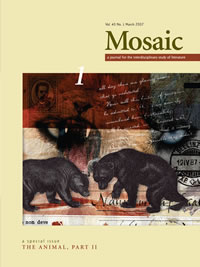Issue 40.1
Overview

Special Issue: The Animal - Part II
Published: March 2007
See the issue summary and contents below.
13 essays, totalling 224 pages
$22.95 CAD
In this, its first issue of 2007, Mosaic presents a second special collection on the topic of "the animal," a companion issue to Volume 39.4, another twelve explorative and innovative contributions to an all-important new field. Look for essays on Coetzee and Gowdy, Shakespeare and Nietzsche, English and Scottish ballads, and medieval animal trials. From Aesop's animals to "mad cow" disease, from dinosaurs to cyborgs, these essays engage the animality question, in all of its complexity and fascination. Look also in this issue for an interview with John Sallis, one in the Mosaic "Crossings" series.
Crossings: An Interview with John SallisDawne McCance On 16 July 2006, Dawne McCance conducted the following interview with John Sallis on the occasion of the thirty-first meeting of the Collegium Phaenomenologicum in Città di Castello, Italy. Mosaic is grateful to John Sallis for taking time for the interview from his very full schedule in Città. We are honoured to publish the interview here, as one in the Mosaic “Crossings” series that explores intersections of the critical and creative, the philosophical and literary. | |
Foot in Mouth: Animals, Disease and the Cannibal ComplexHelen Tiffin The world-wide panic occasioned by outbreaks of BSE was (and is) incommensurate with the number of human fatalities incurred. This apparent over-reaction can in part be accounted for by BSEs simultaneous disruption of cherished “boundaries” between those categories (civilization and savagery; cannibalism and carnivory; human and animal) upon which our human self-definition depends. | |
On Marrying a Butcher: Animality and Modernist Anxiety in West’s “Indissoluble Matrimony”Carrie Rohman This essay suggests that West’s story exposes forms of racialized and gendered mastery that are coded as a failed attempt to eliminate and transcend animality. The exposure is read as a sophisticated commentary on species anxiety in modernist literature, a rhetorical problem that is still critically under-thought. | |
Quia Ego Nominor Leo: Barthes, Stereotypes and Aesop’s AnimalsTom Tyler Taking Barthes’ discussion of Aesop’s lion as a starting point, this essay examines two uses to which the animals of philosophy and critical theory have been put: as ciphers and as indices. The twin dangers to theory’s beasts, of becoming either examples of a deadening, generic ‘animal’ or stultifying stereotypes, are assessed and potential solutions proposed. | |
Theory from the Fringes: Animals, Ecocriticism, ShakespeareSimon Estok This essay offers ecocritical discussions of animals in Shakespeare, in the spirit of the activist goals that ecocriticism cherishes. Balancing close readings with theory, the essay suggests reasons why animals have remained on the fringes of environmentalist and ecocritical discussions, and it brings animals into the discussion in viable theoretical ways. | |
Dog and Dinosaur: The Modern Animal StoryPatricia E. Chu This essay discusses the modern animal story in relation to histories of moving image culture and cybernetics. “New anthropomorphisms” in Jack London’s White Fang, Mamoru Oshii’s Ghost in the Shell 2: Innocence and Robert T. Bakker’s Raptor Red index the effects these have had on our paradigms of modern subjectivity. | |
The King Buzzard: Bano Qudsia’s Postnational Allegory and the Nation-StateMasood Ashraf Raja Using Bano Qudsia’s Urdu novel Raja Gidh as a point of departure, this essay analyses the ambivalent role of the novel in articulating the national and postnational tendencies of the Islamic world in general and Pakistan in particular. | |
Speciesism and Species Being in Do Androids Dream of Electric Sheep?Sherryl Vint Criticism on Do Androids Dream of Electric Sheep? has focused on androids and ignored animals. The novel’s ethical concerns are best understood through animal studies, revealing political deployments of the species boundary to disenfranchise certain humans. The novel suggests another model of subjectivity best understood through Marx’s “species being.” | |
“Mean, dangerous, and uncontrollable beasts”: Medieval Animal TrialsAnila Srivastava While most contemporary Western legal systems treat animals as chattels to be acquired, controlled, and disposed of at their owners’ pleasure, animals have historically been treated as partial legal persons to allow the legal system to respond to the unpredictable and sometimes fatal harms they cause. | |
The Beast Within: Animals as Lovers in Child’s The English and Scottish Popular BalladsGoldie Morgentaler Drawing on both folklore studies and literary analysis, this essay contends that the figure of the animal paramour in the Child ballads represents, in objectified form, the inherent animality and duality of human nature. Ballads featuring sexual relations between humans and anthropomorphic animals address the complex human interaction with the natural world. | |
Memory, Hybridity and Creative Alliance in Haruki Murakami’s FictionAmy Ty Lai This essay explores the use of animals in Haruki Murakami’s fiction, where animals serve as the emblem of selfhood; where human-animal hybrids manifest the fragmented self; and where becoming-animal inspires a creative process which human can fare better. | |
A Defense of Anthropomorphism: Comparing Coetzee and GowdyOnno Oerlemans A comparison of Coetzee’s Disgrace and Gowdy’s The White Bone reveals that while it is possible to generate sympathy for animal being while resisting describing animal sentience in human terms, anthropomorphism can be a valuable and sophisticated strategy for depicting animal minds. | |
Portrait of the Artist as a Bear: Jazz, Nietzsche and the Animal MaskJerome Stueart How does an author use a talking animal in realistic fiction? This essay examines the history of bears in legend and literature, as well as theories of Nietzsche and jazz, in order to understand Rafi Zabor’s saxophone-playing bear in The Bear Comes Home as a literary protagonist and a jazz artist in search of his groove. |